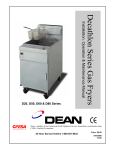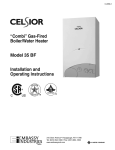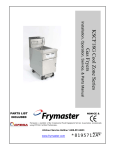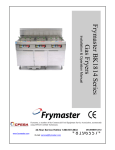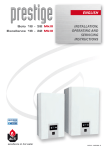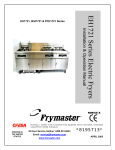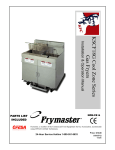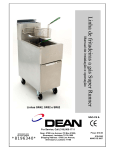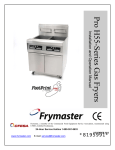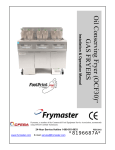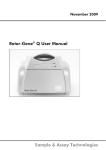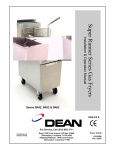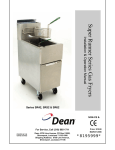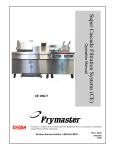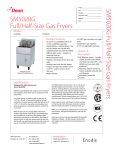Download 819-5727 - Frymaster
Transcript
24G Series Flatbottom Gas Fryers (CE) Installation, Operation & Maintenance Manual CE ONLY Frymaster, a member of the Commercial Food Equipment Service Association, recommends using CFESA Certified Technicians. 24-Hour Service Hotline 1-800-551-8633 Price: $6.00 819-5727 11-99 FLATBOTTOM GAS FRYER Series 24G (CE) TABLE OF CONTENTS 1. 2. 3. 4. 5. 6. 7. 8. 9. FACTORY SERVICE AND PARTS ORDERING IMPORTANT INFORMATION INSTALLATION OPERATION CLEANING AND MAINTENANCE SOLID STATE THERMOSTAT CONTROLLER TROUBLESHOOTING PARTS LIST WIRING DIAGRAM 1. FACTORY SERVICE & PARTS ORDERING 1.1 ORDERING PARTS: Customers may order parts directly from their local Authorized Parts Distributor. For this address and phone number, contact your Maintenance & Repair Center or call the factory. The factory address and phone number are on the cover of this manual. To speed up your order, the following information is required: Ordering Parts Model Number Type Serial Number Type of Gas Optional Equipment Item Part Number Quantity Needed Service Information Model Number Type Serial Number Type of Gas Optional Equipment Nature of Problem 1.2 SERVICE INFORMATION: Call the Frymaster Service Hotline number on the cover of this manual or 1-318-865-1711 for the location of your nearest Maintenance & Repair Center. Always give the model and serial numbers of your filter and fryer. To assist you more efficiently, follow the Service Information chart when calling for service information. Also provide any other information which may be helpful in solving your service problem. After Sales Servicer Address Telephone/Fax Model # Serial # Type of Gas: 1.3 AFTER SALES: In order to improve service, have the After Sales chart filled in by the Frymaster Authorized Servicer who installed this equipment. Fryer Equipped For: 2 PAGE 2 3 6 17 18 19 21 23 25 2. IMPORTANT INFORMATION 2.1 DESCRIPTION: The Frymaster Flatbottom Series 24G Fryers are energy-efficient, gas-fired units, design-certified by the International Approval Services (AGA/CGA), AFNOR, NSF International and manufactured to their basic performance and application specifications. All units are shipped completely assembled with accessories packed inside the frypot. All units are adjusted, tested and inspected at the factory before shipment. Sizes, weights and input rates of all models are listed in this manual. NOTE: The on-site supervisor is responsible for ensuring that operators are made aware of inherent dangers of operating a deep fat fryer, particularly aspects of oil filtration, draining, and cleaning of the fryer. 2.2 PRINCIPLE OF OPERATON: A reliable draft inducer is used to draw air over the burners for combustion. This air movement directs the combustion products back and forth across the underside of the flatbottom vessel by means of a set of baffles, transferring heat to every area evenly. Since the draft inducer operates only during the combustion cycle, all cold air is prevented from entering the combustion chamber and cooling the oil during the coasting cycle. 2.3 RATING PLATE: This is attached to the inside right-hand corner of the front door panel. Information provided includes the model and serial number of the fryer, kW (BTU/hr) input of the burners, outlet gas pressure in mbar (inches WC) and whether the unit has natural or propane gas orifices. CAUTION DANGER! THE FRYER MUST BE CONNECTED ONLY TO THE TYPE OF GAS IDENTIFIED ON THE ATTACHED RATING PLATE. Local building codes usually prohibit a fryer with its open tank of hot oil form being installed beside an open flame of any type, whether a broiler or open burner of a range. 2.4 PRE-INSTALLATION: a. GENERAL: Only a licensed plumber should install any gas-fired equipment. 1. A manual gas shut-off valve must be installed in the gas supply line ahead of the fryer(s) for safety and ease of future service. 2. The Flatbottom Series 24G gas fryers require 230 volts AC and are equipped with a 16-3 SJT grounded flexible power cord for a direct connection to a 230 VAC power supply. Amperage draw for each unit depends on the accessories supplied with the unit. See detailed instructions packaged with the fryer line-up. 3 b. CLEARANCES: The fryer area must be kept free and clear of all combustibles. This unit is design-certified for the following installations: 1. Other than household use. 2. Non-combustible floor installation equipped with factory-supplied 15 cm (6 inch) adjustable legs or 13 cm (5 inch) casters. 3. Combustible construction with a minimum clearance of 15 cm (6 inches) side and 15 cm (6 inches) rear, and equipped with factory-supplied 15 cm (6 inch) adjustable legs or 13 cm (5 inch) casters. 2.5 AIR SUPPLY & VENTILATION: Keep the area around the fryer clear to prevent obstruction of combustion and ventilation air flow as well as for service and maintenance. a. Do not connect this fryer to an exhaust duct. b. A proper installation and adjustment will ensure adequate air flow to the fryer system which input is 2m3 per hour per kW for gas supplied. c. A commercial, heavy-duty fryer must vent its combustion wastes to the outside of the building. It is essential that a deep fat fryer be set under a powered exhaust hood or that an exhaust fan be provided in the wall above the unit, as exhaust gas temperatures are approximately 427 538°C (800 - 1000°F). Check air movement during installation. Strong exhaust fans in this hood or in the overall air conditioning system can produce slight air drafts in the room. d. Do not place the fryer’s flue outlet directly into the plenum of the hood, as it will affect the gas combustion of the fryer. e. Never use the interior of the fryer cabinet for storage or store items on shelving over or behind the fryer. Exhaust temperatures can exceed 427°C (800°F) and may damage or melt items stored in or near the fryer. f. Adequate distance must be maintained from the flue outlet of the fryer(s) to the lower edge of the filter bank. A minimum of 45 cm (17.75 inches) should be maintained between the flue(s) and the lower edge of the exhaust hood filter. g. Filters and drip troughs should be part of any industrial hood, but consult local codes before constructing and installing any hood. The duct system, the exhaust hood and the filter bank must be cleaned on a regular basis and kept free of grease. 2.6 ALTITUDE: The fryer input rating kW (BTU/hr) is for elevations up to 610 m (2000 feet). For elevations above 610 m (2000 feet), the rating should be reduced four percent (4%) for each additional 305 meters (1000 feet) above sea level. The correct orifices are installed at the factory if operating altitude is known at time of the customer’s order. 4 2.7 RECEIVING AND UNPACKING: Check that the container is upright. Unpack the fryer carefully and remove all accessories from the carton. Do not discard or misplace these, as they will be needed. After unpacking, immediately check the equipment for visible signs of shipping damage. If such damage has occurred, contact the carrier and file the appropriate freight claims. Do not contact the factory, as the responsibility of shipping damage is between the carrier and the dealer or enduser. If your equipment arrives damaged: a. File claim for damages immediately – Regardless of extent of damage. b. Visible loss or damage – Be sure this is noted on the freight bill or express receipt and is signed by the person making the delivery. c. Concealed loss or damage – If damage is unnoticed until equipment is unpacked, notify the freight company or carrier immediately, and file a concealed damage claim. This should be done within fifteen (15) days of date of delivery. Be sure to retain container for inspection. NOTE: Frymaster does not assume responsibility for damage or loss incurred in transit. 2.8 CONVERSION OF UNITS: Pressure: 1 mbar = 10.2 mm water column (mm WC) = 0.4 Inch WC 20 mbar = 204 mm WC = 8 Inch WC 1 Inch WC = 25.4 mm WC = 2.5 mbar Heat Input: 1 kW = 3410 BTU/hr 100 BTU/hr = 0.293 kW Temperature: 0° Celsius = 32° Fahrenheit Temp. in degree Celsius = (Temperature in degree Fahrenheit (F) – 32) X 0.555 100° Celsius = (212° Fahrenheit – 32) X 0.555 5 3. INSTALLATION 3.1 POSITIONING: a. Initial Installation: If installed with legs, do not push against any unit edges to adjust its position. Use a pallet or lift jack to lift it slightly and place it where it is to be installed. b. Relocating The Fryer: If relocating a fryer installed with legs, remove all weight from each leg before moving. Note: If a leg becomes damaged during movement, contact your service agent for immediate repair/replacement of that leg. DANGER! THIS FRYER MAY TIP AND CAUSE PERSONAL INJURY IF NOT SECURED CORRECTLY IN A STATIONARY POSITION. REMOVE ALL SHORTENING BEFORE MOVING FRYER AS IT MAY CAUSE SEVERE BURNS UPON CONTACT. 3.2 LEG AND CASTER INSTALLATION: a. General: 1. Install legs and rear rigid casters near where the fryer is to be used, as neither are secure for long transit. Unit cannot be curb mounted and must be equipped with the legs and rear rigid casters provided. 2. When positioning the fryer, gently lower the fryer into position to prevent undue strain to the legs and internal mounting hardware. Use a pallet or lift jack to lift and position the fryer if possible. Tilting the fryer may damage the legs. 3. The rigid casters must be installed on the fryer rear channel assembly only. 4. Proceed to Step 3.3, Leveling, after legs and rear rigid casters are installed to ensure the fryer is level before using. b. Leg Installation: 1. Remove unit from pallet. 2. Carefully raise unit with forklift, pallet jack, or other steady means. 3. Place one lock washer on each hex head screw. 4. Insert hex head screws with lock washers (1/4-20 threads by ¾" (19 mm) long) through bolt holes of leg mounting plates as shown in the Figure 3-1 on the next page. A locknut has been attached to the top side of the mounting plate at the factory to capture the hex head screw as it is screwed in. 5. Tighten the bolts and nuts with each bolt to 5.65 joules (50 inch-lbs.) minimum torque. 6 c. Installing Rear Rigid Casters: 1. Install casters only at the rear of the unit as shown in the Figure 3-1. Legs must be installed at the front of the fryer. 2. Follow the same instructions for leg installations as given above in steps 3.2.b.1-5. CAUTION For caster retrofit, the unit must be at room temperature and drained of shortening before installing the casters. d. Installing Optional Swivel Casters: 1. Install non-locking casters only at the rear of the unit as shown in the Figure 3-1. 2. Locking casters must be installed at the front of the unit. This allows the fryer to be "locked" in position for safe operations. 3. Follow the same instructions for leg installations as given above in steps 3.2.b.1-5. Structural Back Side Panel Front Channel Rear Channel Side Panel 1/4-20 HX HD Lock Nut Front Door 1/4-20 HX HD Lock Nut Caster Shims if required. Caster Shims if required. Front Channel Front Leg w/Mounting Plate Adjust as needed. Lock Washer Lock Washer 1/4-20 HX HD Screw 1/4-20 HX HD Screw Rear Rigid Caster 13 cm/5 in Locking Caster 13 cm/5 in Leg and Caster Installations Figure 3-1 WARNING! A FRYER MUST BE LEVEL BEFORE FILLING WITH OIL. IF THE FRYER IS NOT LEVEL, THE FRYER MAY TIP OVER AND MAY CAUSE INJURY TO THE OPERATOR. 7 3.3 LEVELING: a. Place a carpenter’s spirit level across the top of the fryer and level the unit both front-toback and side-to-side. If the fryer is not level, the unit may not function efficiently, the oil may not drain properly for filtering and in a line-up it may not match adjacent units. b. Legs (Only): 1. If the floor is smooth and level, level the unit by using the caster shims. Adjust to the high corner and measure with the spirit level. WARNING! IF OPTIONAL SWIVEL CASTERS ARE USED, LOCKING CASTERS MUST BE INSTALLED ON THE FRYER FRONT CHANNEL. FAILURE TO LOCK CASTERS PRIOR TO OPERATING THE FRYER MAY CAUSE THE FRYER TO MOVE AND CAUSE INJURY TO THE OPERATOR. 2. Adjust leg height with an adjustable or 1-1/16” (27mm) open end wrench by turning the hex bullet on the bottom of the leg. See figure 3-2 . 3. The hex bullet is for minor leg height adjustment only. Do not adjust more than 1" (22mm). 4. When leveling the unit, the leg body should be held firmly to keep the leg from rotating while turning the hex bullet foot to the required height. c. Rigid Casters (Only): 1. Install the optional rigid casters on the fryer rear channel only. Legs must be installed on the front channel. Adjust leg height with an adjustable wrench. Figure 3-2 2. Do not use more than two metal shims per caster. 3. There are no thread adjustments for the rigid casters. d. Swivel Casters (Only): WARNING! 1. If optional swivel casters are used, the locking swivel casters must be installed on the fryer front channel. Lock casters prior to operating the fryer. 2. Install non-locking swivel casters on the fryer rear channel only. 3. Do not use more than two metal shims per caster. 4. There are no thread adjustments for the swivel casters. 8 DO NOT USE MORE THAN TWO METAL SHIMS PER LEG/CASTER. USING MORE THAN TWO SHIMS PER LEG/CASTER MAY CAUSE THE FRYER TO BECOME UNSTABLE, TIP OVER, AND MAY CAUSE INJURY TO THE OPERATOR. e. If the floor is uneven or has a decided slope, it is recommended to place the fryer on a smooth platform. Do not rely on leg thread or caster shims for adjustments. f. If the fryer is moved, re-level the fryer following the instructions given in Steps 3.3.a-c. g. ANSI Z83.11a-1997 requires a fryer be restrained to prevent tipping when installed in order to avoid the splashing of hot liquid. The means of restraint may be the manner of installation, such as connection to battery of appliances or installing the fryer in an alcove, or by separate means, such as adequate ties. A bracket has been provided on the fryer back panel for this purpose. The install must be reviewed at the time of installation to ensure it meets the intent of these instructions. The on-site supervisor and/or operator(s) should be made aware that there is a restraint on the appliance and, if disconnection of the restraint is necessary, to reconnect this restraint after the appliance has been returned to its originally installed position. CAUTIONS The fryer MUST be connected to the voltage and phase as specified on the rating and serial number plate located on the back of the fryer door. A ground wire MUST be connected to the ground terminal provided near the input power terminal block. 3.4 GAS CATEGORIES: The Flatbottom Series 24G Gas Fryers have obtained CE markings for countries and gas categories shown below: Countries BE Belgium DE Germany DK Denmark ES Spain FR France GB Great Britain GR Greece IR Ireland Supply Pressures and Gas (mbar) G20 20/25 G31 37 G20 20 G31 50 Appliance Categories G20 20 I2H G20 G31 G20/G25 G31 G20 G31 G20 G31 G20 G31 20 37 and 50 20/25 37 and 50 20 37 20 37 and 50 20 37 9 IIE2(R)B; I2E (R)B I2E I3P II2H3P II2ESI3P II2H3P II2H3P II2H3P Countries Supply Pressures and Appliance Categories Gas (mbar) IT Italy G20 G20/G25 G31 G25 NL The Netherlands G31 G20 PT Portugal G31 LU Luxembourg 20 I2H 20/25 50 25 50 20 II2E3P II2L3P II2H3P 37 3.5 GAS CONNECTIONS: The gas supply (service) line must be the same size or greater than the fryer inlet line. This fryer is equipped with a 19 mm (3/4”) male ISO 7.1 inlet; however, the gas supply lines must be sized to accommodate all the gas-fired equipment that may be connected to that gas supply. Consult your contractor, gas company, supplier, or other knowledgeable authorities. Piping Sizes CAUTION Number of Fryers All connections must be sealed with a joint compound suitable for LP gas, and all connections must be tested with a soapy solution before lighting any pilots. Natural Gas Propane Gas 1 2 to 3 19mm (3/4”) 13mm (1/2”) 25mm (1”) 19mm (3/4”) 4 and more (*) 33mm (1 ¼”) 25mm (1”) Piping Sizes: According to the number of fryers to be connected, the gas supply line must be sized as indicated in the chart below: (*) When exceeding 6 meters for a configuration of more than 4 fryers, it is necessary to provide a 33mm (1 ¼”) rigid gas connection. CAUTION The fryer must be isolated from the gas supply piping system by closing its individual, manual shut-off valve during any pressure testing of the gas supply piping system at pressures equal to or less than 50 mbar (5 kPa). WARNING! PUTTING AN OPEN FLAME BESIDE A NEW CONNECTION IS NOT ONLY DANGEROUS, BUT WILL OFTEN MISS SMALL LEAKS THAT A SOAPY SOLUTION WILL FIND. a. Rigid Connections: The fryer can be connected singularly or as part of a cooking line. Check any installer-supplied intake pipe(s) visually and clean threading chips, or any other foreign matter before installing into a service line. If the intake pipes are not clear of all foreign matter, the orifices will clog when gas pressure is applied. b. Flexible Couplings & Connectors: 1. A restraining bracket is provided on the structural back of the fryer to prevent the unit from moving from its installed position. 10 The fryer must be restrained by means independent of the flexible coupling or connector in order to limit the movement of the fryer. 2. CE Standards: If the unit is to be installed with flexible coupling, use a commercial flexible coupling certified as NF D 36123 (or other national standard) or a quick disconnect device certified NFD 36124 (or other national standard). d. Manual shut-off valve: This gas service supplier-installed valve must be installed in the gas service line ahead of the fryer in the gas stream and in a position where it can be reached quickly in the event of an emergency. e. Orifices: The fryer can be ordered to operate on either natural or propane gas. The correct safety control valve, appropriate gas orifices, and pilot burner are installed at the factory. While the valve can be adjusted in the field, only qualified service personnel should make any adjustments with the proper test equipment. f. Pressure regulating: 1. External regulators are not normally required on this fryer, as that function is performed by a safety control valve. 2. If the incoming pressure is in excess of 50 mbar (5 kPa), a step-down regulator will be required. Your local servicer should check the manifold pressure with a manometer. 3.6 ADJUSTMENTS / ADAPTATION TO DIFFERENT GASES: a. Proper operation of appliances requires operator to scrupulously inspect the following adjustments in terms of : CAUTION 1. gas inputs and pressures ; air adjustment; 2. voltage and polarities of electrical power supply. The fryer and its individual shut-off valve must be disconnected from the gas supply piping system during any pressure testing of the gas supply piping system at test pressures in excess of 50 mbar (5 kPa). b. Frymaster gas fryers are manufactured to use the type of gas and pressure specified on the rating plate. When changing gas, adaption must be done by qualified personnel. Failure to use qualified personnel will void the Frymaster warranty. c. GAS INPUTS: G20 1. Nominal Qn Heat Input is : 30 kW. G25 2. Inputs for different gases are as follows : 11 Natural Gas 20mbar: 3.172 m3 / hr. (Type H) Natural Gas 25 mbar: 3.689 m3 / hr. (Type L) G31 Propane 37mbar: 2.329 kg / hr. (1.225 m3 / h.). G31 Propane 50mbar: 2.329 kg / hr. 3.7 ADJUSTMENT TO DIFFERENT GASES CHART: GASES AND PRESSURES SUPPLY (1) Diameter and markings of injectors Burner Pilot G20 20 mbar G25 25 mbar G31 37 mbar G31 50 mbar 2.50 mm 2.50 mm 1.60 mm 1.60 mm "blue" marking "blue" marking "red" marking "red" marking TJ024 TJ024 TJ013 "red" TJ013 "red" 21 (4) 31 31 Opening maximum a = 15 mm a = 15 mm (2) Gas pressure at the 14.5 regulator (mbar) (3) Burner air adjustment Opening "a" maximum (1) – (2) : For controls and adjustments, please refer to "gas valve" illustration. NOTE: Outlet gas pressure must be controlled with precision 5 to 10 minutes after appliance is operating. (3) : For air adjustment "a", please refer to "air adjustment" illustration. Position injectors properly. (4) : Except Belgium (without adjustment between G20 and G25 - 14.8 mbar). (Pilot: Use the pilot flow adjustment screw mounted on top of the gas valve to adjust flame volume.) 3.8 STEPS TO FOLLOW DURING GAS CONVERSION: a. From G20 to G25: ♦ No replacement of equipment. ♦ Adjust gas pressure to orifices by turning the gas valve "adjustment screw". ♦ After adjustment, seal the screw. ♦ See Air Adjustment and Gas Valve diagrams on pages 13 and 14. ♦ Put label on the gas valve. CAUTION Any adaptation, modification, or gas conversion must be performed by qualified personnel only. Failure to use qualified personnel will void the Frymaster warranty. b. From G20 (or G25) to G31 propane (or vice versa). ♦ ♦ ♦ ♦ Replacement of burners orifices and pilot. Adjust gas pressure to orifices by turning the gas valve adjustment screw. After adjustment, seal the screw. See Air Adjustment and Gas Valve diagrams on pages 13 and 14. ♦ Change label "fryer equipped for" and affix WARNING! it to the rating plate. Erase gas that is not used. IF GAS ODORS ARE DETECTED ♦ Put label on gas valve. THE GAS SUPPLY MUST BE SHUT OFF AT THE MAIN SHUT-OFF c. Important : for the same gas: VALVE AND THE LOCAL GAS COMPANY OR AUTHORIZED ♦ G25 / 25 mbar or 20 mbar SERVICE AGENCY CONTACTED ♦ G31 / 37 mbar or 50 mbar FOR SERVICE. ♦ no change is to be executed on the appliance. 12 d. When changing gas family – i.e changing from natural gas to propane, please order the necessary kit as indicated hereafter. This change can only be executed by a qualified and factory authorized personnel. e. The complete kits for gas conversion (natural gas to propane/propane to natural gas) include the following parts: Natural Gas to Propane Kit QTY REF DESCRIPTION 1 TJ013 3 1826 - 50 1 Label Propane to Natural Gas Kit QTY REF DESCRIPTION Pilot injector 2 TJ024 Pilot injector Burner injector (diam. 1.60 mm) Appareil réglé pour : G31 / 37 Fryer equipped for : 50 2 1826 - 40 1 Label Burner injector (diam. 2.50 mm) Appareil réglé pour : G20 / 20 Fryer equipped for : G25 / 25 * Air Adjustment 13 CE Gas Valve Pilot Light Button Pressure Flow Adjustment Off Button Side View Top View Thermocouple Connection Pilot Flow Adjustment Outlet Pressure tap 3mm Inlet Pressure tap 3mm Bottom View 3.9 ELECTRICAL CONNECTIONS: Refer to the rating plate located inside the front door. The wiring diagram is attached to the inside of the fryer door also. The diagram can also be found in Chapter 8. The fryer is equipped with a 230VAC single-phase 50 hertz system. All electrically operated appliances must be electrically grounded to conform to CE standards. Do not cut or remove the ground prong from the power cord plug. Respect the phase – neutral polarity. Do not attempt to use the fryer during a power outage. Off Button Pressure Flow Adjustment WARNING! WHEN LIGHTING PILOTS AND CHECKING FOR BURNER PERFORMANCE, DO NOT STAND WITH YOUR FACE CLOSE TO THE BURNERS… THEY MAY LIGHT WITH A “POP” AND COULD CAUSE FLASH BACK AND FACIAL BURNS. Pilot Light Button CE Gas Valve 14 3.10 INITIAL START-UP: a. Cleaning: New units are wiped clean with solvents at the factory to remove any visible signs of dirt, oil, grease, etc. remaining from the manufacturing process, then coated lightly with oil. Wash thoroughly with hot, soapy water to remove any film residue and dust or debris before food preparation, then rinse out and wipe dry. Wash also any accessories shipped with the unit. Close the drain-valve completely and remove the crumb screen. Make sure the screws holding the thermostat and high limit control sensing bulbs into the frypot are tight. b. Initial Pilot Light: All Frymaster fryers are tested, adjusted and calibrated to sea level conditions before leaving the factory. Adjustments to assure proper operation may be necessary on installation to meet local conditions, low gas pressure, differences in altitude, variations in gas characteristics, to correct possible problems caused by rough handling or vibration during shipment, and are to be performed only by qualified service personnel. These are the responsibilities of the customer and/or dealer and are not covered by Frymaster warranty. 1. The inlet pipe at the lower rear of the fryer brings incoming gas to the pilot safety control valve, then to the pilot and/or main burners. The pilot is located high in the cabinet center, at the base of the frypot. It will require a long match or taper to light. 2. Ensure that the following steps are done in sequence before lighting or re-lighting the pilot: a) Turn off the manual shut-off valve on the incoming service line. b) Turn the operating thermostat “OFF”. c) Depress the red pilot gas button on the safety control valve to ensure gas valve is “OFF”. CAUTION When the frypot is filled with water, do not drain the water form the frypot into the filter. This will damage the filter pump and void the warranty. d) Wait at least 5 minutes for any accumulated gas to disperse. 3. Fill fryer tank with liquid oil (or water during testing) to the “oil level” line scribed into the rear wall of the tank. a) Open the manual shut-off valve on the incoming service line. b) Apply a lighted match or taper to the pilot burner head. c) Press the white pilot gas button to provide gas to the pilot. Continue depressing the button until the pilot stays lit when the button is released. This may take a minute or longer. c. If the pilot does not stay lit, depress the white button and re-light it, holding the white button in longer before releasing. It may be necessary to re-light the pilot several times until the lines are purged of any trapped air and a constant gas flow is attained. d. When the pilot stays lit, release the white pilot button. e. Turn the thermostat to any “ON” setting and watch to make sure the main burner ignites from the pilot. 15 3.11 HEATING THE FRYPOT: This step will check main burner operation, initial thermostat calibration, and clean the frypot for initial food production. a. Fill the frypot with hot or cold water to the oil level line scribed in the back of the frypot. b. Set the operating thermostat/ temperature controller dial to 104°C, just above that of boiling water. c. The main burner will ignite. d. Reset the temperature controller to 93°C. e. The burners should shut off just as the water starts to boil. f. When satisfied that the burners and thermostat are operating properly, drain the frypot of water and dry thoroughly. Refill it with shortening as directed below. 3.12 FINAL PREPARATION : a. When using a liquid shortening (cooking oil), fill the fryer to the “oil level” line scribed into the back of the frypot. b. When using a solid shortening, either premelt it on another appliance first, or cut into small pieces and tightly pack it, leaving no air spaces and being careful not to disturb the sensing bulbs. c. If the fryer does not have a Melt Cycle Control, turn the burners “ON” for about ten seconds, “OFF” for a minute, etc., until the shortening is melted. If you see any smoke coming from the shortening while melting this way, shorten the “ON” cycle and lengthen the “OFF” cycle. Smoke shows that you are scorching the shortening and reducing its useful life. NOTE: Never melt a solid block of shortening by setting it whole in the frypot. This is unsafe, inefficient and dangerous. d. Before starting operation, turn the operating thermostat to the probable working temperature; wait for the temperature to stabilize then check with a high-quality immersion thermometer. WARNINGS! DO NOT GO NEAR THE AREA DIRECTLY OVER THE FLUE OUTLET WHILE THE FRYER IS OPERATING. ALWAYS WEAR OIL-PROOF, INSULATED GLOVES WHEN WORKING WITH THE FRYER FILLED WITH HOT OIL. ALWAYS DRAIN HOT OIL INTO A METAL CONTAINER. HOT OIL CAN MELT PLASTIC BUCKETS AND CRACK GLASS CONTAINERS. 16 4. OPERATION 4.1 INITIAL LIGHTING: Check the fryer for: CAUTION a. Gas valve off. Never operate fryer with an empty frypot. This can severely damage the frypot. b. Power switch off, if equipped. c. To light the fryer, see Section 3.11. General use: Use a high-quality liquid frying compound. If using solid shortening, always pack fry vessel tightly with shortening up to the fill line. Attempting to melt loosely packed blocks of shortening can damage the fry vessel. Frying temperature: Although 177°C is often listed as the optimum cooking temperature, frying should be carried out at the lowest temperature that will produce a high-quality product while ensuring maximum life of the cooking oil. When not in use, the temperature controller should be set lower than the usual operating temperature. 4.2 SOLID STATE CONTROLLER: See Chapter 6 for using this optional controller. 4.3 FILTERING: a. When using your filtration system, always refer to the Installation and Operation Manual for your Frymaster Filter System. b. General: 1. Filter the frying compound at least once daily or more frequently if cooking is heavy. CAUTION When filtering, never leave the filter unattended. Oil moving through the lines could jar a flexible return hose out of the filter pan., spraying hot oil and causing severe burns. This assures the longest life possible for the frying compound, a better taste to the food and minimizes flavors being transferred. 2. If using solid shortening, clear return lines before turning off the filter motor by allowing the pump to run for approximately 10-15 seconds once air bubbles appear in the fry vessel from the oil return line. Failure to do so will allow solid shortening to cool, solidify and clog the lines. 4.4 CLOSING: When closing at night, filter oil in all fryers and drain the filter lines. Cover the open tanks of oil. Turn power switch “OFF”. 4.5 SHUTDOWN: When shutting down for longer than overnight, drain the frying compound and clean the vessel thoroughly. Either discard the frying compound or return it filtered to the vessel and cover it. Turn both the power switch and the temperature controller “OFF”. Turn the manual valve on the incoming service line or combination gas valve off. Disconnect any 230-volt power cords from the wall sockets or turn off the circuit breakers. 17 5. CLEANING & MAINTENANCE 5.1 GENERAL: Any piece of equipment works better and lasts longer when properly maintained and cleaned. The fryer must be kept clean during the workday and thoroughly cleaned at the end of each day. 5.2 DAILY: Wash all removable parts. Clean all exterior surfaces of the body. Do not use cleansers, steel wool or any other abrasives on the stainless steel. Filter the cooking oil and replace if necessary. Filter oil more often under heavy conditions. 5.3 WEEKLY: WARNING! DO NOT LET WATER SPLASH INTO THE TANK OF HOT OIL. IT WILL SPLATTER AND CAN CAUSE SEVERE BURNS. a. Completely drain the fryer vessel into either the filter or a steel container. Do not use a plastic bucket or glass container. b. Clean the vessel with a good grade of cleaner or hot water and a strong detergent. c. Close the drain valve and refill with either the cleaning solution or water and detergent. d. Follow the Boil-Out procedures. Bring to a simmer, then turn the heat down and let the mixture stand until deposits and/or carbon spots can be rubbed off with a brush. e. Scrub tank walls and bottom, then drain vessel and rinse in clear water. f. Refill with clear water, set operating thermostat to 104°C and simmer again. g. Once cleaning is complete, turn temperature controller “OFF”, drain, rinse and dry thoroughly. h. Refill with cooking oil or frying compound as directed in this manual. 5.4 PERIODIC: The fryer should be checked and adjusted periodically by qualified service personnel as part of a regular kitchen maintenance program. CAUTION Do not drain water into the filter. Water will damage the filter pump. 5.5 STAINLESS STEEL: All stainless steel fryer body parts should be wiped regularly with hot, soapy water during the day and with a liquid cleaner designed for this material at the end of the day. a. Do not use steel wool, abrasive cloths, cleansers or powders! b. Do not use a metal knife, spatula or any other metal tool to scrape stainless steel! Scratches are almost impossible to remove. c. If it is necessary to scrape the stainless steel to remove any encrusted materials, soak the area first to loosen the material, then use a wood or nylon scraper only. 18 6. SOLID STATE THERMOSTAT CONTROLLER Power On Light Heat Mode Light Melt Cycle Light Trouble Light ? SOLID STATE C F Power Switch Temperature Knob Melt Cycle Switch ANALOG CONTROLLER 6.1 SWITCHES & INDICATORS: • Power Switch - controls power to the fryer. • Power On Light - indicates when electrical power is on. • Temperature Knob - sets desired frying temperature. • Heat Mode Light - indicates when elements are on (heating). • Trouble Light - indicates solid state controller system lockout. To reset, turn power switch OFF for 30 seconds, then ON. • Melt Cycle Switch - controls melt cycle operation. • Melt Cycle Light - indicates fryer is operating in the melt cycle mode. CAUTION Before turning on the solid state controller, the fryer must be filled with oil, shortening, or water up to the lower "oil level" line scribed on the fry vessel back wall. 6.2 CONTROLLER OPERATION: a. Ensure the fry vessel is filled with oil, shortening, or water. b. Place the power switch in the ON position. 19 c. Set the temperature knob for the desired frying temperature. d. Place the melt cycle switch in the ON position. The controller will operate in the melt cycle mode until the shortening reaches 180°F (82°C). Upon reaching 180°F (82°C), the controller will automatically switch to normal operation. The controller will cycle the heating elements ON for 3 seconds and then OFF for 12 seconds until the shortening reaches 180°F (82°C). The heat cycle light cycles ON for 3 seconds and OFF for 12 seconds while the fryer is in melt cycle mode. e. During normal operation, the heat light will come ON when the elements are heating. Once the setpoint temperature is reached, the heat light will go OFF unless the oil temperature drops. Then the controller will turn the elements ON to heat the shortening up to setpoint again. Note: Normally, when frozen product is dropped into the fry vessel, the shortening temperature will drop enough to cause the heating elements to heat (heat light ON) until setpoint is reached again. 6.3 THERMOSTAT CALIBRATION: a. Insert a good grade thermometer or pyrometer probe into the cooking oil/shortening near the fryer temperature sensing probe. b. Turn the thermostat knob to frying temperature. c. Let the fryer heat till it reaches setpoint temperature. This will take up to 30 minutes from a cold start, less if the fryer has been in use during the day. d. Let the elements cycle ON and OFF automatically 3 times in order the cooking oil/shortening temperature to be uniform. Stir, if necessary, to get all the cooking oil/shortening in bottom of fry vessel melted. e. When elements cycle ON for the 4th time, the thermometer/pyrometer should be within ± 5°F (2°C) of the thermostat knob setting. If it is not, calibrate as follows: 1. Loosen set screw thermostat control knob until outer shell of knob will rotate on insert inside knob. 2. Rotate outer shell of knob until index line on knob aligns with marking that corresponds to thermometer or pyrometer reading. 3. Hold knob and tighten set screw. 4. Recheck the thermometer or pyrometer reading and the thermostat knob setting the next time the elements come on. 5. Repeat steps 1-4 above until thermometer or pyrometer reading and knob setting agree within ± 5°F (2°C). 6. If calibration cannot be obtained for any reason, call a Factory Authorized Service Center. f. Remove thermometer/pyrometer and conduct normal operations if thermostat has been calibrated successfully. 20 7. TROUBLESHOOTING The problems and possible solutions given cover those most commonly encountered by operators. If you have questions concerning procedures described or need the local telephone number of your Factory Authorized Servicer, call 1-(318) 865-1711 (Worldwide) or 1-(800) 551-8633 (U.S./Canada). 7.1 PILOT BURNER MALFUNCTION: • Check that gas valve is open and gas is present at the valve. a) Pilot will not ignite; no evidence of gas at pilot burner. • Check pilot burner adjustment (beneath cover screw). Adjust pilot flame to extend approximately 13 mm above the top of the pilot burner. Replace cover screw. • Remove pilot gas supply line and check for dirt; blow out if necessary, then reinstall. • Check pilot orifice for dirt. • Check that the thermocouple is firmly screwed into pilostat power unit bushing on the gas control. b) Pilot burner ignites but will not remain lit when it is released. • Remove end of thermocouple lead from pilostat power unit bushing and clean with fine sandpaper. Also check that the bushing is clean of debris and oil. If thermocouple is defective – replace. • Pilot flame may be too high or too low. Adjust flame by turning pilot flow adjustment (refer to item (a) above. c) Pilot burner ignites and burns properly, but goes out when exhaust blower comes on. • Pilot flame may be adjusted too low, even though it appears to be satisfactory. Readjust higher. • Pilot flame may be adjusted too high and is on the verge of blowing out. Adjust pilot flame lower. CAUTION Do not attempt to operate unit during power failure. 7.2 MAIN BURNER MALFUNCTION: • Cooked product or other material may have fallen into the flue and lodged in the blower wheel, preventing it from turning. Clean out flue and blower wheel. a) Blower is not operating although power is present at the fryer. • Blower motor may have overheated and shut off on thermal overload. This condition will correct itself when the motor cools (in about 20 minutes). If problems with blower overheating persist, call for service. 21 • Check that gas valve is open. • Check that pilot is ignited and is operating properly. • The combination gas control valve may be defective; contact a Factory Authorized Service Center for service. b) Main burner will not come on; no gas present at main burner. • Check the high temperature safety switch. Replace if defective. • Check the air prover switch as follows: Move the actuating lever at the switch to make sure it is not dragging in the slots. If so, bend arm carefully to clear the obstruction. (Use a long tool in moving this switch to avoid burns.) Check the air prover switch for continuity. Replace if defective. Actuating lever for air prover switch must not drag in slot. IMPORTANT The purpose of the air prover or “sail switch” is to assure that the main burner does not come on unless the blower, which is energized by the temperature control, is in operation and is moving air through the fryer to provide combustion air and exhaust the products of combustion. The normally open switch is mounted in an electrical junction box adjacent to the blower scroll and motor. When the blower is put into operation, the airflow is detected and proved by the motion of the vane portion of the switch, which then actuates and completes the gas control circuit. c) Main burner flames are small and • Contact a Factory Authorized Service Center. appear lazy; frying compound does Problem may be with gas pressure at the combination not come up to temperature gas valve. quickly. d) Signs of excessive temperature; frying compound scorches and quickly becomes discolored. • Cooking compound of inferior quality or used too long. Replace. • If problem persists, contact a Factory Authorized Service Center. Problem may be caused by a short circuit in the system, inconsistent gas pressure, or faulty/out of calibration operating thermostat. 22 8. PARTS LIST FOR FLATBOTTOM 24G (CE): 13 1 24 9 11 12 10 14 8 16 21 6 17 27 20 19 2 24 18 5 3 25 4 22 7 26 30 23 31 29 28 32 ITEM 1 2 3 4 5 6 7A 7B 8 9 PART # 523-0002 506-0001 500-0001 506-0002 507-0003 506-0003 523-0003 523-0004 510-0011 506-0004 DESCRIPTION Frypot, Flatbottom Outlet Duct Assembly (CE) Airgate, Flatbottom (CE) Inlet Duct Assembly Blower Motor, 230V, 60/50Hz Air Prover Switch (Sail Switch) Side Panel, Left Hand Side Panel, Right Hand Side Flame Spreader Secondary Air Baffle Assembly 23 8. PARTS LIST FOR FLATBOTTOM 24G (CE) (Continued): ITEM PART # 10 11 12 13 14 15 16 17 18 19 20 21 22A 22B 23 24A 24B 25 26 27A 27B 28A 28B 28C 29 30 31 32A 32B 32C 506-0005 506-0006 510-0002 501-0111 506-0007 507-0004 501-0053 510-0003 507-0005 810-1001 510-0004 510-0005 510-0006 510-0007 506-0008 807-1999 807-0979 501-0058 806-7965 806-3006 806-8312 807-2091 501-0101 812-1256 507-0006 501-0015 506-0009 501-0033 510-0008 501-0032 507-0007 506-0010 510-0009 523-0005 506-0011 500-0002 510-0010 DESCRIPTION Fire Box Assembly Drain Valve Assembly with Micro Switch Drain Valve, Std., 2.54mm (1") Micro Switch, Drain Valve Sensor Probe Assembly High Limit with Manual Reset Filter Power Switch Control Panel Thermocouple Igniter, Piezzo Mark 21 Gas Manifold Assembly Tubular Burners Gas Jet (Natural Gas) Gas Jet (Propane) Door Assembly with Lining Transformer, CE, 230V/24V - Not Shown Transformer, CE, 230V/12V - Not Shown Relay, DPDT, 24VAC Interface Board Solid State Controller Computer Magic III Computer Gas Valve, 24V, CE, HW, Natural Gas Gas Valve, 24V, CE, HW, LP Connector, ECO, Gas Valve Power Switch Lower Hinge Bracket Leg Support Assembly Caster with Brake, 127mm (5") Caster without Brake, 127mm (5") Leg, Black, 152mm (6") - Not Shown Fuse, 2 Amp - Not Shown Power Cord Set - Not Shown Basket Hanger Assembly Crumb Tray - Not Shown Frypot Cover - Not Shown Structural Back - Not Shown Fuse, 5 Amp - Not Shown 24 Temp Probe PN 807-1108 BLK WHT RED 24V Transformer PN 807-1999 230V YEL#2 12V 230V WHT WHT#2 BLK#2 YEL#2 WHT BLK#2 To Solid State Controller or CMIII Computer 1 2 3 4 5 6 7 8 9 10 11 12 13 14 15 Computer Interface Board 1 2 3 4 5 6 7 8 9 10 11 12 GND J2 1 2 3 4 5 6 7 8 9 10 11 12 WHT RED YEL#2 BRN WHT WHT Blower Motor BRN 1 BLU 2 1 3 5 7 2 4 6 8 1 2 3 4 5 6 7 8 9 10 11 12 13 14 15 To Interface Board BRN BLU PUR BLU 1 2 PUR BRN PUR BRN PUR Relay, DPDT 24VAC PN 501-0058 2 4 6 8 Hi-Limit Thermostat WHT RED BLK#2 WHT Solid State Controller PN 806-7254 Computer Magic III Computer PN 806-8312 RED 1 3 5 7 Relay, DPDT 24VAC PN 501-0058 WHT Drain Microswitch PN 501-0111 BLU NO NC Air Prover Switch BRN WHT GRN To Oil Return Circuit 5 Amp Fuse WHT#2 RED 5 Amp RED BRN Motor Fuse Holder Transformer PN807-0979 WHT 25 BLU YEL#2 BLU 230VAC Solder Connection ECO Connector Assy BLU Valve Adaptor Gas Valve 24VAC/50HZ Threaded to valve WHT Thermocouple G31 LP Gas PN 501-0101 G20, G25 Nat Gas PN 501-0100 Electrode Lead Wire Piezo Ignitor PN 810-1001 9. WIRING DIAGRAM (CE Flatbottom 24G Gas, 230VAC/50Hz) Frymaster, L.L.C., 8700 Line Avenue, PO Box 51000, Shreveport, Louisiana 71135-1000 Shipping Address: 8700 Line Avenue, Shreveport, Louisiana 71106 TEL 1-318-865-1711 FAX (Parts) 1-318-219-7140 PRINTED IN THE UNITED STATES SERVICE HOTLINE 1-800-551-8633 (Tech Support) 1-318-219-7135 Price: $6.00 819-5727 11-99




























